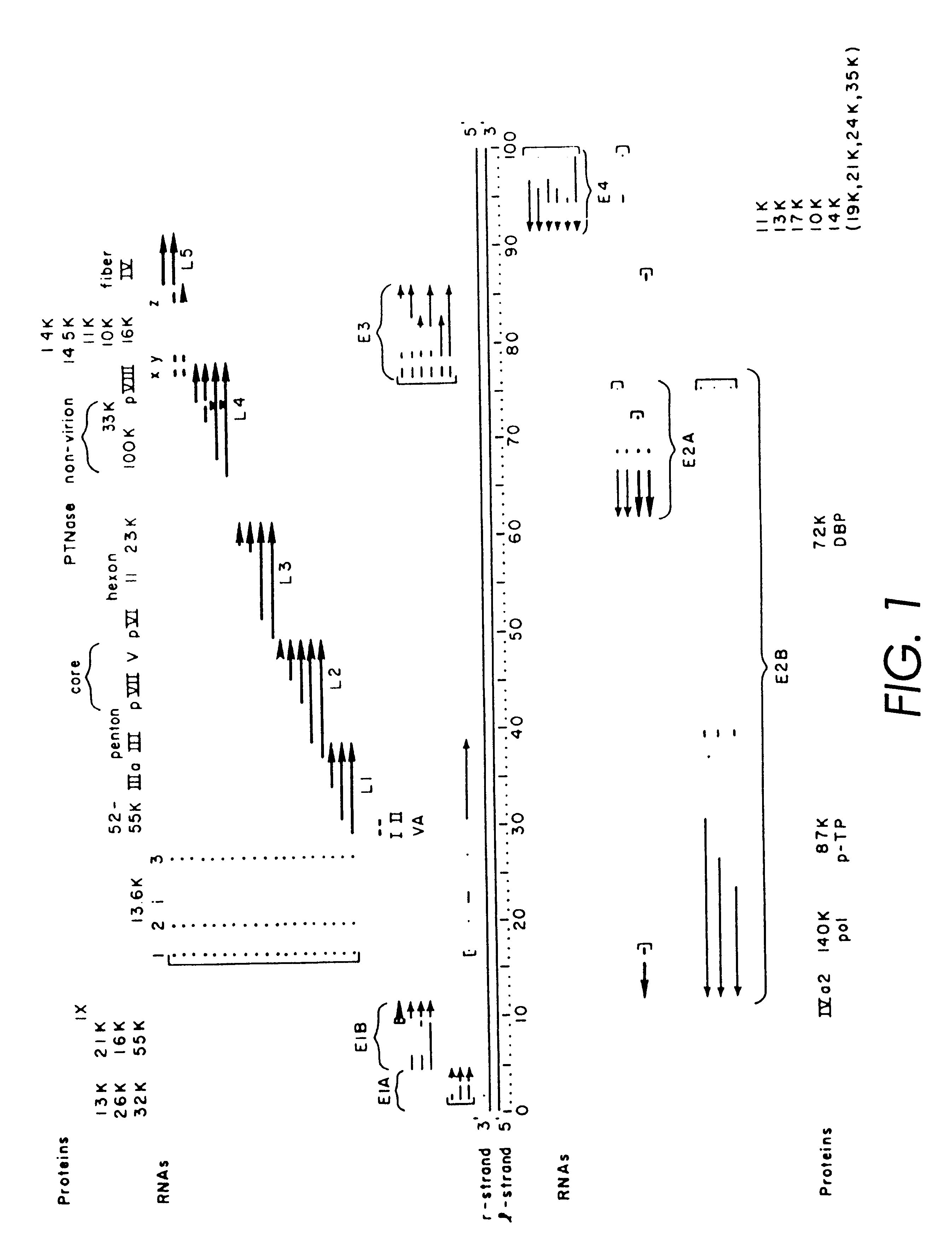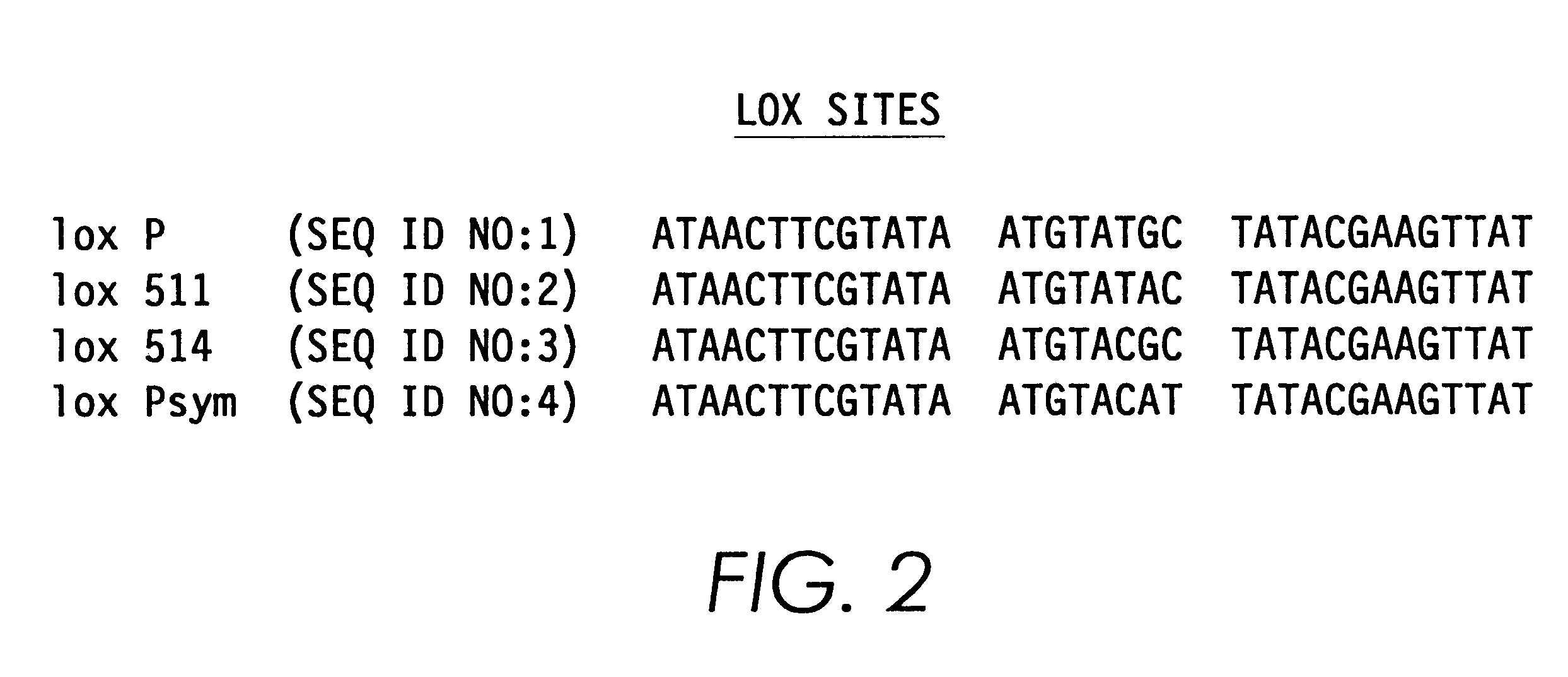Helper-free, totally defective adenovirus for gene therapy
- Summary
- Abstract
- Description
- Claims
- Application Information
AI Technical Summary
Benefits of technology
Problems solved by technology
Method used
Image
Examples
example 1
Construction of the .psi.5 Helper rAd Vector
The starting material for construction of the helper rAd vector .psi.5 was a plasmid containing the following sequences in order: an SfiI restriction site, nucleotides 2 to 553 from Ad5 (nucleotide 1 is the last C of the SfiI site), an XhoI restriction site, the human CMV immediate-early promoter from -600 to +1 relative to the start of transcription, the polylinker sequence from pSP73 from the HindIII site to the EcoRI site, a polyadenylation signal from SV40 (nucleotides 2752 to 2534 of SV40), pSP73 sequence from nucleotide 2 through 2382 (containing ClaI, EcoRV, and BglII sites), an ApaI restriction site, the right ITR from Ad5. The ApaI-SfiI fragment containing the right ITR was made by polymerase chain reaction. For ease of manipulation the SfiI fragment was cloned into the PvuII site of pBluescript.sup.+ to give pCMV-Ad. Cleavage of pCMV-Ad with SfiI releases the original SfiI fragment.
Next, a single lox P site (chemically synthesize...
example 2
Construction of a Therapeutic rAd Vector Minus Lox Site
A minimal rAd vector was constructed containing the ITRs, Ad packaging site and about 27 kb of foreign DNA. This prototype therapeutic rAd vector did not contain a lox site.
The starting material was pCMV Ad described in Example 1. The 22 kb BglII A fragment from .lambda. phage DNA was inserted between the BamHI and the BglII sites of pCMV Ad. A 5 kb BamHI DNA fragment containing a CMV immediate early promoter, the .beta.-galactosidase gene and SV40 polyadenylation signal was also inserted into the BglII site. The resulting plasmid, pA.beta., contains a 28 kb DNA fragment, including an Ad packaging site, bounded by two ITRs. The ITR bounded fragment can be excised by SfiI digestion.
To determine whether this vector would be replicated and packaged in vivo with a helper virus, pA.beta. treated in various ways was co-transfected with Adenovirus DNA into 293 cells. The treatments were as follows: 1) pA.beta. transfected as circular p...
example 3
Isolation of Cre8 Cre-expressing Host Cell Line
To make a stable cell line expressing Cre recombinase, 293 cells were transfected with plasmid pML78 using the CaPO.sub.4 precipitation method (Graham et al. Virology 52:456-467 (1973)). pML78 contains the Cre recombinase gene, modified to include a Kozak sequence at the start of translation and a nuclear localization signal at the N-terminal, under the control of a human .beta.-actin promoter and followed by the poly A signal from .beta.-actin. pML78 also contains a selectable neomycin resistance gene.
At 48 hr. after transfection, the cells were transferred into culture medium containing G418. After selection on G418 for 17 days, 12 resistant colonies were recovered and expanded.
As a first step in characterization of the transfectants, Western blot analysis was performed on cell extracts. A 10 cm dish of cells (about 1.6.times.10.sup.7 cells) was washed once with phosphate buffered saline (PBS) and the cells were suspended in 5 ml PBS ...
PUM
| Property | Measurement | Unit |
|---|---|---|
| Time | aaaaa | aaaaa |
| Digital information | aaaaa | aaaaa |
| Digital information | aaaaa | aaaaa |
Abstract
Description
Claims
Application Information
 Login to View More
Login to View More - R&D
- Intellectual Property
- Life Sciences
- Materials
- Tech Scout
- Unparalleled Data Quality
- Higher Quality Content
- 60% Fewer Hallucinations
Browse by: Latest US Patents, China's latest patents, Technical Efficacy Thesaurus, Application Domain, Technology Topic, Popular Technical Reports.
© 2025 PatSnap. All rights reserved.Legal|Privacy policy|Modern Slavery Act Transparency Statement|Sitemap|About US| Contact US: help@patsnap.com



